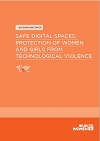
Background-Safe Digital Spaces: Protection of Women and Girls from Technological Violence

The rapid advancement of information and communication technologies (ICTs) increased the opportunities for communication and use of ICTs in a number of innovative ways. However, ICTs are also harming and threatening women and girls in a number of ways. Technology-assisted Violence against Women and Girls is emerging as a global problem with serious implications for societies and economies around the world. Reports now suggest that an incredible 73 percent of women have been exposed to some form of violence online. The statistics pose risks to the peace and prosperity for all enshrined in the Charter of the United Nations, and, in particular, to the goals of inclusive, sustainable development that puts gender equality and the empowerment of women as key to its achievement . As the use of information and communication technologies has become more omnipresent, the use of these technologies as a weapon against women has also become ubiquitous. In addition, internet and social media have also become environments where women are often made to feel unsafe and are threatened. Violence against women is being committed through the use of media such as texting, email, face book, twitter, you tube and just about any other internet or social media platform you can think of. More so, data shows that cyber-violence against women is very prevalent among the youth. This is very well showcased by media stories of many young girls affected by aggravated sexual assault and sexting. This paper analyses the ways in which technology helps women and contributes to achieving Sustainable Development Goals (SDGs) , examines the various forms of technology-assisted violence against women and their impact and consequences in the light of the global and Africa region frameworks, how this type of violence impacts women’s lives, where various African governments are in terms of policy provision to access justice for victims, and proposed recommendations to end the vice. The paper argues that making accessible the ICTs and filling the gender divide is important in achieving the Sustainable Development Goals (SDGs). It also seeks to offer collective understanding of what technology-assisted violence against women and girls constitutes. It further makes recommendations to address tech- violence against women and girls with emphasis on the transformative change in making digital world accessible and safe for women and girls.